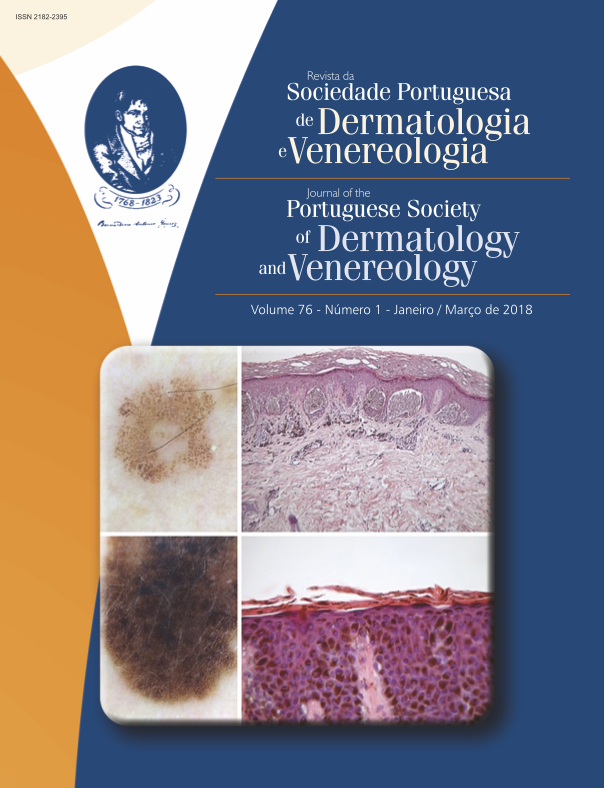Esporotricose e seu Polimorfismo Clínico: Um Caso com Lesões Ulceradas na Região Centro Facial em Paciente Adulto.
Resumo
Esporotricose é a micose subcutânea mais comum no mundo, causada por fungos dimórficos e geofílicos, das espécies Sporothrix spp. A forma linfo cutânea é a apresentação clinica mais comum e o acometimento facial é mais prevalente na faixa etária pediátrica, devido à baixa estatura e ao hábito de brincar com felinos próximo a face. Nesse relato de caso, uma paciente do sexo feminino, com diagnóstico prévio de rosácea, residente na cidade do Rio de Janeiro, área epidêmica da doença, apresentou lesões ulceradas no dorso nasal, lábio superior e glabela, diagnosticada tardiamente como esporotricose.
Downloads
Referências
Carrasco Zuber JE, Navarrete Dechent C, Bonificaz A, Fich F, Vial-Leterlier V, Berroeta Mauriziano D. Parte 1: micosis subcutâneas. Actas Dermo-Sifiliográf. 2016;107: 806-15.
Reis BD, Cobucci FO, Zacaron LH, D’Acri, AM, Lima RB, Martins CJ. Sporotrichosis in an unusual location: a case report. An Bras Dermatol. 2015;90 (3 Suppl 1):S84-7.
Bernardes-Engemann AR, de Lima Barros M, Zeitune T, Russi DC, Orofino-Costa R, Lopes-Bezerra LM. Validation of a serodiagnostic test for sporotrichosis: a follow-up study of patients related to the Rio de Janeiro zoonotic outbreak. Med Mycol. 2015 53:28-33.
Araujo ML, Rodrigues AM, Fernandes GF, Camargo ZP, Hoog GS. Human sporotrichosis beyond the epidemic front reveals classical transmission types in Espírito Santo, Brazil. Mycoses. 2015;58: 485–90.
Barros MB, Schubach Ade O, do Valle AC, Gutierrez Galhardo MC, Conceição-Silva F, Schubach TM, et al. Cat-transmitted sporotrichosis epidemic in Rio de Janeiro, Brazil: description of a series of cases. Clin Infect Dis. 2004; 38:529–35.
Read SI, Sperling LC. Feline sporotrichosis. Transmission to man. Arch Dermatol. 1982;118:429-31.
Gremião ID, Menezes RC, Schubach TM, Figueiredo AB, Cavalcanti MC, Pereira SA. Feline sporotrichosis: epidemiological and clinical aspects. Med Mycol. 2015;53:15-21.
Orofino-Costa R, Macedo PM, Bernardes-Engemann AR. Hyperendemia of sporotrichosis in the Brazilian Southeast: learning from clinics and therapeutic. Curr Fungal Infect Rep. 2015;9:220–8.
Rafal ES, Rasmussen JE. An unusual presentation of fixed cutaneous sporotrichosis: a case report and review of the literature. J Am Acad Dermatol. 1991; 25(5 Pt 2):928-32.
Mahajan VK, Sharma NL, Shanker V, Gupta P, Mardi K. Cutaneous sporotrichosis: unusual clinical presentations Indian J Dermatol Venereol Leprol. 2010;76:276-80.
Bargman HB. Sporotrichosis of the nose with spontaneous cure. Can Med Assoc J. 1981;124:1027.
Martins-Costa GM, Bonamigo RR. Facial verrucous sporotrichosis in an adult during treatment for rosacea. Int J Dermatol. 2014;53: e80–e157.
Song JG, Song YB, Yun SY, Suh MK, Ha GY, Kim JR, et al. Cutaneous sporotrichosis presenting as clinical feature of facial cellulitis in an adult. Ann Dermatol. 2016;28:507-8.
Sharma NL, Mehta KI, Mahajan VK, Kanga AK, Sharma VC, Tegta GR. Cutaneous sporotrichosis of face: polymorphism and reactivation after intralesional triamcinolone. Indian J Dermatol Venereol Leprol. 2007;73:188-90.
Bernardes-Engemann AR, Orofino-Costa R, Miguens BR, Penha CV, Neves E, Pereira BA, et al. Development of an enzyme-linked immunosorbent assay for the serodiagnosis of several clinical forms of sporotrichosis. Med Mycol. 2005; 43:487–93.
Mahajan VK. Sporotrichosis: an overview and therapeutic options. Dermatol Res Pract. 2014;2014:272-376.
Kauffman CA, Bustamante B, Chapman SW, Pappas PG; Infectious Diseases Society of America. Clinical practice guidelines for the management of sporotrichosis: 2007 update by the Infectious Diseases Society of America. Clin Infect Dis. 2007;45:1255-6.
Machado T, Dantas C, Prohmann C, Silva L, Montes L, Gatti R, et al. Esporotricose na infância: Mimetizando Leishmanise: Evolução favorável com iodeto de potássio: Rev Soc Port Dermatol Venereol. 2017;75: 183-5.
Todos os artigos desta revista são de acesso aberto sob a licença internacional Creative Commons Attribution-NonCommercial 4.0 (CC BY-NC 4.0).








